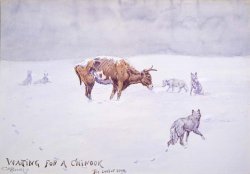
There’s an old saying in the Lone Star State that there “ain’t nothin’ between Texas and the North Pole but an old barbwire fence and it’s down most of the time.”
I’ve been reminded of that saying often in the past week and about stories of the early days of barbed wire in Texas.
During the 1880s, many ranchers erected so-called “drift fences” from east to west on their northern boundary to prevent outside cattle from drifting down and foraging on their range. A separate fence was also often strung up on the southern boundary to prevent cattle from drifting south “out of the country.”
Barbed wire drift fences stretched across the entire northern Panhandle of Texas by 1885. But they soon proved to be a devastating liabilty, as blizzards and freezing temperatures hit the southern plains in late December 1885 and the following winter of 1886-87. When cattle turned their tails to the Arctic wind and drifted south, they were eventually stopped in their tracks by fences. As more and more cattle arrived, they became crammed against the fences in immobile packs and eventually froze to death.
When the storms dissipated, thousands of dead cattle were found piled against drift fences. Some ranchers estimated herd losses up to 75 percent. Hands on the LX Ranch reportedly skinned 250 carcasses per mile for 35 miles along one section of drift fence.
Lewis Nordyke, in Great Roundup, reported that cattle were stacked up along the Panhandle drift fence in piles 400 yards wide and cowboys said that “a man could walk from Kingsley, Kansas to the Colorado line using cattle carcasses as a path and never touch the ground.” When the thaw finally came, a Panhandle merchant purchased 45,000 hides that were by-products of what came to be referred to as the “Big Die-Up.”
Artist Charles Russell captured the devastation of the storms, which extended from Montana into Texas, in Waiting for a Chinook (also titled Last of the 5000), a painting that helped launch his career.
In 1899, the “Big Freeze” arrived in three successive Arctic blasts and brought some of the coldest temperatures to ever hit Texas. Ice covered Galveston Bay, people skated on the San Antonio River, and Dallas County registered a record 10 degrees below zero. Once again ranchers suffered losses, but nothing to compare to the Big Die-Up.
